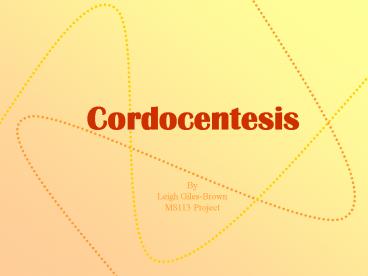By - PowerPoint PPT Presentation
1 / 14
Title: By
1
Cordocentesis
By Leigh Giles-Brown MS113 Project
2
History
- 1954 First attempts at fetoscopy (precursor to
cordocentesis). - Hysteroscope Endoamnioscope Needlescopes
- 1983 Fernand Daffos pioneers ultrasound-guided
cordocentesis. - First case of Hemophilia A diagnosed in utero.
- 1985 Hobbins group at Yale University describes
their technique as percutaneous umbilical blood
sampling. This replaces blood sampling via
fetoscopy in U.S. - - Kypros Nicolaides at Kings College Hospital
in England develops single operator
two-hands method. - Late 1980s Cordocentesis becomes more
available and accepted as a quick confirmation
of abnormal karyotype when ultrasound suggests
a chromosomal abnormality.
3
Why Cordocentesis?
- Identify genetic disorders if amniocentesis or
Chorionic Villi Sampling unsuccessful or
inconclusive. - Detect fetal blood disorders such as hemophilia,
anemia, and blood oxygen levels. - Detect viral infections (rubella, toxoplasmosis,
cytomegalovirus) - Recommended for mothers known to be sensitized to
Rh factor if - Fetus has hydrops.
- Bilirubin levels from amniocentesis show moderate
or severe damage. - Bilirubin levels are rising quickly.
- Fetus signs of severe anemia during 2nd
trimester. - Doppler ultrasound of middle cerebral artery
shows anemia.
4
Technology
Cordocentesis Trainer simulates gravid abdomen
- Used with any ultrasound equipment.
- Contains a fetal cord, filled with mock blood,
suspended in gel (does not include fetus). - Includes 2 placentas (anterior and posterior),
enabling both direct and transplacental
approaches to the cord. - The mock blood in the foetal cord can be
replenished. - Used for needle insertion and placement however,
no fluid can be withdrawn from the amniotic sac. - Self-sealing abdomen and cord can be pierced
repeatedly.
5
Training
http//www.limbsandthings.com/usa/products.php?pa
rtno60203
6
Procedure
- Usually performed as outpatient.
- Mother provided a sedative to reduce her and
fetus movement. - Fetus may be injected with medicine to stop
movement. - Mother may be given antibiotics to prevent
infection or preterm labor. - Local anesthetic is injected into abdomen.
- Ultrasound is used to locate placental cord
insertion. - Ultrasound imaging guides needle insertion into
umbilical vein. - Small amount of blood is withdrawn.
7
Procedure
http//www.shands.org/health/pregnancy/stayhealthy
/articles/pubs.html
8
Procedure
http//www.shands.org/health/pregnancy/stayhealthy
/articles/pubs.html
9
Sonographic Appearance
http//www.sonosite.com/screen_images_gallery_file
s/PW-01.jpg
10
Sonographic Appearance
http//www.womenshealthsection.com/content/obs/fig
6.gif
11
Results and Treatment
- Monitoring
- if Rh sensitization effects mild to moderate
- AND
- no severe anemia in fetus.
- Fetal Blood Transfusion
- if Rh sensitization effects are severe
- AND
- severe fetal anemia
- Subsequent fetal blood transfusions may be
required until it can be delivered safely
12
What are the Benefits?
- Early intervention and treatment are possible
(early as 17th week). - Usually performed after an amniocentesis or
Doppler ultrasound when more specific results are
required. - Cordocentesis gives a more direct and reliable
estimate of the fetal condition. - Enables parental decisionmaking (termination,
planning for child with special needs, medical
intervention).
13
Worth the Risks?
- Miscarriage rate of 1-2.
- Fetal bleeding and blood mixing risk is higher
than amniocentesis. - Possible vaginal bleeding (rare).
- Small risk of infection.
- Possible drop in fetal heart rate (constantly
monitored during procedure). If performed after
26 weeks, could require emergency ceasarean if
baby too distressed (rare). - Leaking amniotic fluid with possible premature
rupture of membranes.
14
REFERENCES
American Pregnancy Association. Cordocentesis
Also Known as Fetal Blood Sampling, Percutaneous
Umbilical Blood Sampling, and Umbilical Vein
Sampling. 2/5/2004. http//www.americanpregnancy
.org/prenataltesting/cordocentesis.html Birth.co
m. Cordocentesis. 2004. http//www.birth.com.au
/class.asp?class6602page7 WebMDHealth.
Fetal Blood Sampling (FBS) for Rh Sensitization
During Pregnancy. 9/2003. http//my.webmd.com/hw
/being_pregnant/hw141283.asp WebMDHealth.
Hydrops Fetalis. 5/30/2004. http//my.webmd.com
/hw/health_guide_atoz/hw141264.asp?navbarhw135945
Woo, Joseph, M.D. A Short History of the
Development of Ultrasound in Obstetrics and
Gynecology. http//www.ob-ultrasound.net/history3
.html Woo, Joseph, M.D. A Short History of
Amniocentesis, Fetoscopy and Chorionic Villus
Sampling. 9/18/2004. http//www.ob-ultrasound.net
/amniocentesis.html































